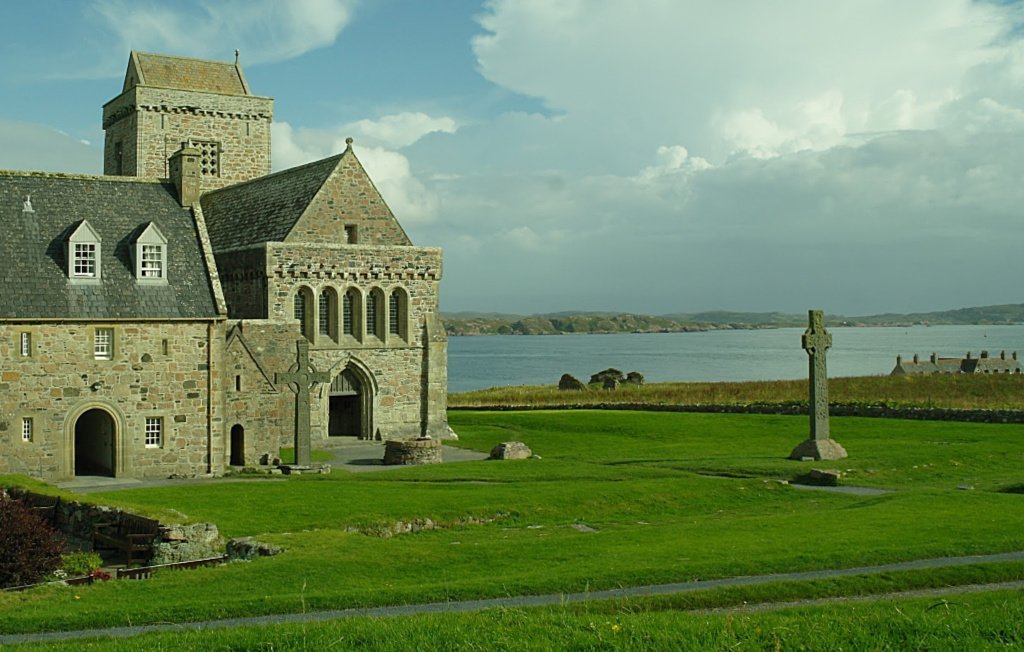Whether it’s St Columba on Iona or the Fairy Pools on Skye, you know how Scottish tourism promotion is all about marketing these days? Well, it used to be about information provision. The industry used to have information experts who actually knew something about the product.
Actually knowing a ton of stuff about Scotland is old hat now and tourism is all about slick promotion and presentation. (Oh, wait, except for this website, obviously.)
Still with me? Oh good. Now, today’s tourism marketing people know all about branding. But the chances are, they don’t know a lot of Scotland’s history and heritage.
So I thought it might be helpful if at least a little of Scotland’s history is translated into marketing terms for them as it helps them understand the product.
So let’s start with one of the most significant historical figures in the early part of Scotland’s story: St Columba.

So here’s my take on the St Columba brand and how it developed, all translated into the kind marketing-speak young folk in tourism today can get their heads round
Obviously, St Columba isn’t as big a brand as, say, St Michael, the patron saint of staid retailing.
But he’s almost as big a name as St Andrew, patron saint of several countries including Scotland, and also of fishmongers, amongst other categories.
The Life Of St Columba
And his career in sales and marketing.
OK, marketing folk, listen up. You have to understand this. St Columba is crucial in today’s sales pitch for the island of Iona. Here’s what you need to know.
It all started back in the 6th century, when an Irish high-born monk called Columba had a falling-out (in Ireland) with another career-driven monk over copying some religious tract or other, over which – can you believe – a pitched battle was fought and much blood spilled in AD561. (Religions, eh?)
Basically, it was a copyright issue over some promotional material.
Columba felt bad about the whole affair. That, plus the excommunication memo he got from the rest of the guys in the firm, sent him off to Scotland, where he fetched up on the island of Iona.
Determined to get his curriculum vitae looking better, he re-wrote his sales pitch and went off to assess the market potential of the Pictish tribes living in eastern Scotland.
They, up to that point, had been happy with the service they had been getting from Druids Ltd. Columba got them a better deal, as he told them he had the ear of the big boss upstairs.
He kept head office on the island of Iona, but started several branches in various other parts of Scotland.
Eventually, there was a big training operation there as well as a publishing arm. (The best-seller was ‘The Book of Kells’. They only printed one copy, but it turned out to be priceless.)
Press event at which Loch Ness Monster turned up (apparently).
While on a sales mission up north, Columba did a local press event that involved scaring away some beastie in the River Ness that was about to attack a swimmer, the whole affair later contributing to the Loch Ness Monster legend – another hugely successful Scottish brand. (Ultimately the most successful piece of Scottish marketing – ever.)
Columba eventually died in AD597 and by this time had a tremendous reputation for impressive tricks (aka ‘miracles’) at workshop sessions – for example, casting demons out of milk pails, restoring spilt milk into milk pails and several that didn’t involve milk at all.

Vikings – hostile takeover bid
All went well with the company even when Columba wasn’t around and the business prospered at the Iona HQ until Vikings arrived in AD794.
Long before they got into office furniture, they were aggressive operators and under the ‘Pagans-r-Us’ label they made several corporate raids on Iona.
Anyway, much later on, local tribes became clans and wanted a piece of the action. They liked the longevity of the Columba brand, which had withstood the unwelcome Viking bids. They took on a franchise.
The whole tale was so inspiring that around 1200AD Raghnall, son of Somerled, the Lord of the Isles, and Acting Chairman, had to increase staff at the enquiry handling call centre and encouraged Benedictine monks to come to Iona.
Expansion plans: a nunnery
To get staff to an isolated island he had to provide accommodation. He established St Ronan’s Nunnery close by, which at its peak housed up to 400 Augustinian nuns.
(Yes, monks and nuns in close proximity, isolated little island….that’s funny, I thought the same…Still, there must have been some great office parties.) The ruins of this building still stand.
That’s all you need to know. The brand is still popular, bringing thousands every year to the little island.
In the old company HQ, Iona Abbey, you can still see the mediaeval base, though like all other such establishments in Scotland it fell into ruin after the Reformation, and has been extensively refurbished.
Today it is the focus of the Iona Community, an ecumenical group who do lots of practical good works.
Here’s more on the Isle of Iona.
